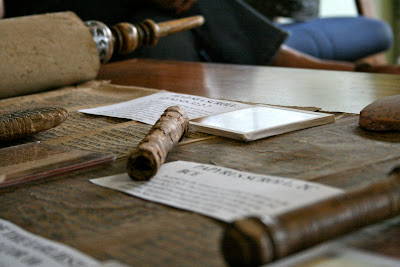I walked out into the Mid-ships Lounge to find priceless artifacts and manuscripts laid out carefully on our little cheap coffee tables. Among the manuscripts there was a blackened fragment from a Dead Sea scroll.
The history and origin behind the Dead Sea scrolls is simply fascinating. In 1947 a young Bedouin Sheppard was out looking for a sheep he had lost. The Sheppard wandered up to a cave and threw a stone in, hoping he would hear his sheep, instead he heard the sharp shattering of a clay jar that had been left undisturbed for 2000 years until now.
Let’s take a quick detour back in time to understand where exactly these scrolls came from and why they ended up hidden away in the caves of Qumran.
The Essenes were a Jewish people group who separated themselves from civilization so that they could focus entirely on preparing themselves for the day when the long awaited Messiah would come. Cleansing through water was a key ritual for the Essenes, they bathed several times per day in mikvehs. They lived simple, strict lives, everything belonged to the group and nothing belonged to the individual.
There was a particular group of Essenes’ who lived in Qumran, Israel in first century BC, before the destruction of the temple in Jerusalem. It was rumored that John the Baptist was an Essene at Qumran; for he was “preparing the way”, living simply and preaching in the wilderness and baptizing with water; all key teachings of the Essenes.
Among their daily rituals and jobs, the Essences were very good scribes. They wrote 972 scrolls, amongst their texts that they copied there were: Biblical texts, Apocryphal texts and sectarian texts which are documents which speak of the rules, rituals and believes of a particular groups of Jews within Judaism.
In 70 A.D Rome destroyed Jerusalem and they did not stop there. The Essen’s knew that they would soon be coming for any other Jewish settlements and so they wisely hid their carefully copied scrolls in the caves above their settlement. This action of hiding them has made many historians and archeologists today, very, very happy. The two most famous scrolls found were the Isaiah scroll as well as the copper scroll.
The Isaiah scroll was the only one entirely intact and almost perfectly preserved. It also proves that the Bible today is extremely accurate because even 2000 years ago the book of Isaiah barely differed from the book today.
The copper scroll was found in cave number three and it begins as follows: "In the fortress which is in the Vale of Achor, forty cubits under the steps entering to the east: a money chest and its (sic) contents, of a weight of seventeen talents."
As you have probably by now guessed, the copper scroll is basically a treasure map. It tells of many places where great quantities of treasure including coins and golden vessels can be found. Many believe it refers to the temple treasure lost so long ago, other believe it is simply a work of fiction-there is no treasure. But for historians and archeologists it is and exciting prospect to ponder and study. The copper scroll is called the copper scroll because it is literally made out of copper, but today the copper does not gleam golden anymore it is instead green with age.
There were other things at the exhibit, ancient seals from the time of Abraham written in cuneiform; the language of ancient Mesopotamia and the first written language in the world. There was a fragment from the Corinthian letter by Paul to the church of Corinth. The fragment was probably from a copy of the letter but the copy was still written in the same time period as the original. I could go on and on about the contents that filled our cheap little coffee tables, but I am sure you must get back to your lives in the present.
 |
| Corinthian Scroll fragment |
 |


Great job, Carys! Very well-written and very fascinating indeed.
ReplyDeletei love it Carys..
ReplyDelete